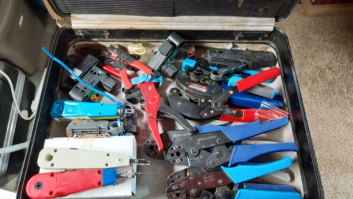
The Reverend Robert J. Geckler is with Ecumenical Communications and the Christian Podcasts Connection. An avid reader of Workbench, Bob offers a problem and a solution.
Most of us have a toolbox that contains those heavy, bulkier tools like big wrenches, pliers, hammers and the like. The weight can make the box a little unwieldy.
All it takes is one time bumping the latch just the right way, and the latch pops open and everything is dumped on the floor — and maybe on your feet! Sound familiar? If you’ve been there, you may be searching for a solution.
Bob’s got one and it’s ingenious. Most toolboxes have a hasp for a lock. But a lock requires a key or a combination to memorize.
A less expensive but helpful solution is shown in Fig. 1. Slip an old-style metal shower curtain hook through the toolbox hasp. It can be quickly removed, costs next to nothing and will prevent a spillover disaster!
***


While we’re looking at pictures, do you have any idea what is pictured in Figs. 2 and 3 (above)? They are both the same component, except Fig. 3 is what it looks like “after” cleaning. Read on for the answer at the end of the article!
***
Although Tom Norman spent many of the last 21 years working in TV (as he puts it, “radio with pictures”) he writes about two issues he has experienced with electrolytics.
The first was tantalum capacitors exploding when asked to get to work in the cold. In Tom’s case, it was the power supply in the RCA TK-760 camera. Because space inside the box was too small for standard electrolytic of the same capacitance and voltage, it was filled with tantalums.
The television studio was not heated except by means of studio lighting. So on sub-zero mornings, the guys would turn on the cameras and invariably one of them would fail to come on. Tom would open it up and clean the mess out of the box, replacing the capacitors and sometimes the series pass switching transistor and associated snubbing diode. He’d put everything back together and turn it on.
Of course, this meant there was one less camera for the morning news, so the crew had to get creative.
Tom’s second issue was with electrolytic capacitors made by Mallory. This is a brand with a rich history (look it up), yet he had so much trouble with its electrolytic capacitors failing that he asked manufacturers whose capacitors they used. If they said, “Mallory,” he would press them for the exact nature of the capacitors (physical form factor, capacitance, voltage) so he could shotgun them when the new gear came through the door. Tom was not going to tolerate Mallory electrolytic capacitors in the plant. Period.
It’s been more than 21 years, and Tom acknowledges that things may have changed. For one thing, in 2002 Cornell Dubilier Electronics Inc. acquired the distributor division of North American Capacitor Company’s Mallory Products Group. Readers, what are your experiences? Tom and I are curious.
Tom’s point about shotgunning (replacing all electrolytics at once) is something to consider. Having an adequate supply of spare electrolytics on hand for your critical gear is a good idea.
Also, don’t forget there is a finite life for electrolytic capacitors. The rule of thumb used to be replacing them every seven years. I’ve seen gear run 10 to 15 years before replacement was required. Regardless of the lifespan, if one of a series of electrolytics goes bad, replace them all.
***
Everyone likes free stuff. Projects engineer Dan Slentz discovered some freeware you may find of interest. He found a button panel that behaves like the old 360 Systems Instant Replay. This software provides a screen of push buttons that can be tied to jingles, drops or liners and selected by the operator/talent.
Many audio playout systems offer a similar function, but if you don’t have one, consider this from Charlie Davy’s Software Shenanigans.
For a low-budget operation, you can’t beat free. Dan also suggests its use for high school ballgame sound effects or other similar uses. While you’re on the site, look over the “Free Stuff” link on the home page.
***
If you identified Figs. 2 and 3 as showing a trimmer capacitor, you’re right. It was sent in by engineering consultant Frank Hertel of Newman-Kees. What he finds most impressive about this capacitor is that despite its age, it adjusts so smoothly. The white base is ceramic, and the spring brass is nickel plated — and still retains its spring tension as if it were new. The insulation between the plates is mica, not plastic.
Contribute to Workbench. You’ll help fellow engineers and qualify for SBE recertification credit. Send Workbench tips and high-resolution photos to [email protected]. Fax to (603) 472-4944.
Author John Bisset has spent 49 years in the broadcasting industry and is still learning. He handles western U.S. radio sales for the Telos Alliance. He is SBE certified and is a past recipient of the SBE’s Educator of the Year Award.











